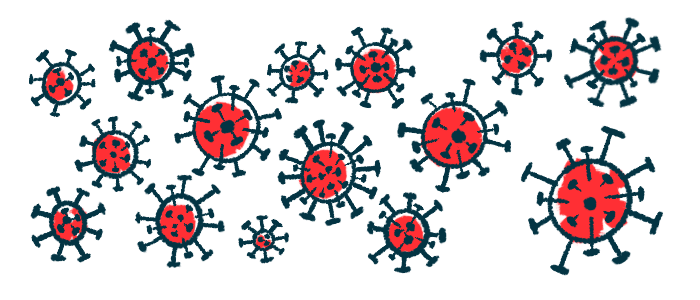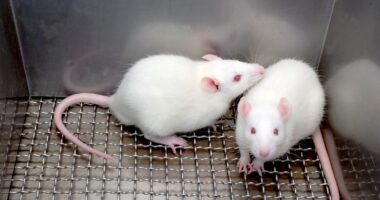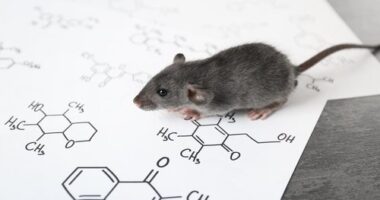More potent viruses promising for Huntington’s gene therapy delivery
AAVs sought that effectively deliver therapies to deep brain regions

Researchers have developed a modified and harmless adeno-associated virus (AAV), called AAV-DB-3, that can efficiently deliver low doses of gene therapies to deep regions of the brain impacted by neurodegenerative diseases such as Huntington’s disease.
AAV-DB-3 was more than 200 times more potent at delivering its genetic cargo to brains of nonhuman primates (NHPs) than other AAV-based gene therapies now being assessed in Huntington’s. It was also effective in human-derived nerve cells and retained its properties in mice, supporting further preclinical testing for Huntington’s.
“These findings suggest that AAV-DB-3 and other … variants from our screening platform are highly promising [viral carriers] for a broad range of neurodegenerative disorders that affect deep brain … regions,” Beverly Davidson, PhD, the study’s senior author at the Children’s Hospital of Philadelphia (CHOP), said in a hospital press release.
The study, “Optimized AAV capsids for basal ganglia diseases show robust potency and distribution,” was published in Nature Communications. It was funded by the CHOP Research Institute and Latus Bio, which is developing new AAV carriers for gene therapies targeting specific tissues.
In Huntington’s, defects in the HTT gene lead to an abnormally long version of the huntingtin protein, which is prone to forming toxic clumps in neurons. Medium spiny neurons, found in a region deep within the brain known as the basal ganglia, are the nerve cells most sensitive to abnormal huntingtin. The malfunction of these neurons due to toxic huntingtin leads to Huntington’s symptoms.
Gene therapies to reduce the production of abnormal huntingtin protein represent a promising treatment strategy for Huntington’s. Such therapies are typically delivered to neurons using modified and noninfectious AAVs.
Still, delivering medicines to these deep brain structures remains challenging in Huntington’s and other disorders that affect the basal ganglia, including Parkinson’s disease.
“One of the main issues plaguing gene therapies today is low potency,” Davidson said in a separate press release. “This results in high doses being required to reach therapeutic levels. High doses increase both patient safety issues and the cost of goods per patient.”
More effective AAVs sought
To address these limitations, Davidson, who’s also the founder of Latus, and her colleagues at CHOP and Latus sought to identify AAVs that more effectively delivered gene therapies to these deep brain regions. The team screened an extensive AAV library by administering them at low doses to the globus pallidus, a major basal ganglia component, of nonhuman primates. Out of millions of potential candidates, a vector called AAV-DB-3 was identified as the most potent.
Experiments showed a single AAV-DB-3 dose consistently delivered its genetic payload to up to 45% of medium spiny neurons in the adult NHP striatum, another basal ganglia component.
AAV-DB-3 boosted levels of the delivered gene’s messenger RNA (mRNA), the molecule derived from DNA that guides protein production, by more than 180 times over AAV5 when administered at identical doses, volumes, and routes. AAV5 is the viral carrier used in AMT-130, an experimental gene therapy being developed for Huntington’s designed to deliver a genetic payload into the basal ganglia during surgery.
In lab-grown human neurons, AAV-DB-3 resulted in a more than 60 times greater increase in mRNA levels derived from the delivered gene relative to its parental vector, called AAV1, when given at equivalent doses. Further, AAV-DB-3 retained its properties of widespread brain distribution in mice, “supporting its application to preclinical testing and relevant dose range finding studies important for advancing to [Huntington’s] patients,” the researchers wrote.
“AAV-DB-3 represents a major step forward in solving one of the biggest challenges in both Huntington’s and Parkinson’s disease gene therapy — delivering genetic payloads precisely and effectively to deep brain structures,” said Jang-Ho Cha, MD, PhD, chief scientific officer at Latus. “Innovations in gene therapy offer hope to patients and their families — potentially turning once-devastating diagnoses into manageable conditions.”
A potent vector for gene therapy
In a second study, titled “An AAV variant selected through NHP screens robustly transduces the brain and drives secreted protein expression in NHPs and mice” and published in Science Translational Medicine, the researchers described a new AAV that could be used to produce proteins as a possible treatment for neurological diseases.
Called AAV-Ep-plus, the vector showed markedly increased potency at delivering its cargo to two types of brain cells in three species of NHPs, two mouse strains, and lab-grown human neurons.
It was then tested in a mouse model of late infantile Batten disease, a genetic, neurological condition that’s also called CLN2 disease and is marked by a deficiency of the TPP1 enzyme.
Administering this vector, when designed to deliver the gene coding for TPP1, directly into the brain of the mice resulted in therapeutically relevant TPP1 levels, significantly reducing symptoms and prolonging survival. In NHPs, the vector also showed higher potency in increasing TPP1 levels in the cerebrospinal fluid (CSF), which surrounds the brain and spinal cord.
“These results suggest that [AAV-Ep-plus] may be a potent vector for gene therapy applications where CSF protein [production] is required,” the researchers wrote.







